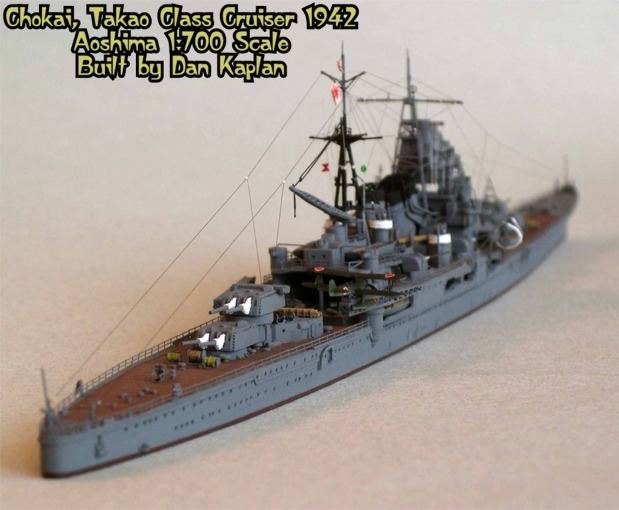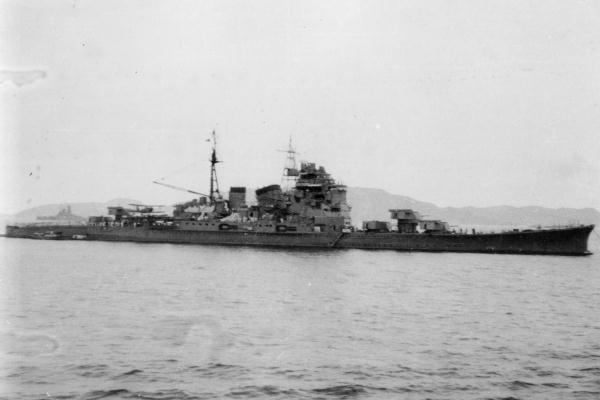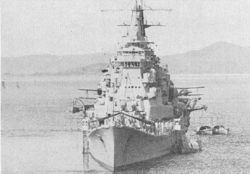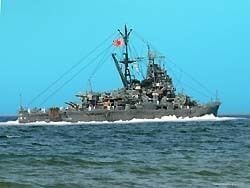Name Chōkai Laid down 26 March 1928 Struck 20 December 1944 Construction started 26 March 1928 Length 204 m Beam 21 m | Commissioned 30 June 1932 Weight 16,030 tons Launched 5 April 1931 Draft 6.3 m | |
 | ||
Builder Mitsubishi Heavy Industries, Ltd. | ||
Chōkai (鳥海) was a Takao-class heavy cruiser, armed with ten 20 cm (8 in) guns, four 12 cm (5 in) guns, eight tubes for the Type 93 torpedo, and assorted anti-aircraft guns. Chōkai was designed with the Imperial Japanese Navy strategy of the great "Decisive Battle" in mind, and built in 1932 by Mitsubishi's shipyard in Nagasaki. She was sunk in the Battle off Samar in October 1944. Chōkai was named for Mount Chōkai.
Contents
- Operational history
- The Guadalcanal campaign
- Subsequent Action
- Battle of Leyte Gulf
- Sunk in the Battle off Samar
- References

Operational history

At the start of the Pacific War, Chōkai supported the invasion of Malaya and participated in the pursuit of the Royal Navy's battleship Force Z. During January and February 1942, Chōkai was involved in operations to seize the oil-rich Dutch East Indies and the island of Borneo. Steaming near Cape St. Jacques, Chōkai struck a reef, sustaining hull damage on 22 February 1942. On 27 February, she reached Singapore for repairs.

After repairs, Chōkai was once again assigned to a support role in an invasion, this time the landings at Iri, Sumatra, and the invasion of the Andaman Islands and the seizure of Port Blair a few days later. Afterwards, Chōkai sailed to Mergui, Burma.

On 1 April 1942, the Chōkai left Mergui to participate in Operation C, a raid on merchant shipping in the Indian Ocean. First, Chōkai torpedoed and sank the U.S. freighter Bienville, and later on, the British steamship Ganges on 6 April. With her role in the operation successfully concluded, Chōkai returned to Yokosuka on 22 April 1942.
The Guadalcanal campaign

By mid-July 1942, Chōkai was made the new flagship of Vice Admiral Mikawa Gunichi and his Eighth Fleet. She proceeded towards Rabaul. On 7 August 1942, with Guadalcanal having been invaded by the Americans, Chōkai headed for the Guadalcanal waters, with Vice Admiral Mikawa aboard. In the battle of Savo Island, Mikawa's squadron of heavy cruisers inflicted a devastating defeat on an Allied squadron, sinking four heavy cruisers (three American and one Australian) and damaging other ships. However, Chōkai sustained several hits from the cruisers Quincy and Astoria, disabling her "A" turret and killing 34 men. Chōkai returned to Rabaul for temporary repairs. For the rest of the Solomon Islands campaign, Chōkai would fight in an assortment of night battles with the U.S. Navy, sustaining varied, but mostly minor, damage.
Subsequent Action

Relieved as the Eighth Fleet flagship shortly after the final evacuation of Guadalcanal, Chōkai headed back to Yokosuka on 20 February 1943. Tasked with various minor duties for the remainder of 1943 and first half of 1944, Chōkai was made the flagship of the Cruiser Division Four ("CruDiv 4") comprising Takao, Maya, Atago, and Chōkai on 3 August 1944. All four ships took part in the Battle of the Philippine Sea.
Battle of Leyte Gulf
CruDiv 4 was part of Admiral Takeo Kurita's large fleet of IJN battleships, cruisers, and destroyers that took part in the various engagements of the Battle of Leyte Gulf at the Philippines.
CruDiv 4 suffered a harrowing submarine attack on 23 October 1944, with the sinking of Maya and Atago (which was Kurita's flagship though he survived), while Takao was left permanently crippled, leaving Chōkai as the only undamaged ship of CruDiv 4.
Chōkai was then transferred to Cruiser Division Five, where she survived an air attack on 24 October 1944, while the battleship Musashi was sunk.
Sunk in the Battle off Samar
On the morning of 25 October, Chōkai engaged an American force of escort carriers, destroyers, and destroyer escorts in the Battle off Samar. During her approach to the US escort carriers, Chōkai was hit amidships, starboard side, most likely by the sole 5 in (127 mm) gun of the carrier White Plains. While the 20 lb (9.1 kg) payload of the shell could not pierce the hull, it set off the eight deck-mounted Japanese Type 93 "Long Lance" torpedoes, which were especially volatile because they contained pure oxygen, in addition to their 1,080 lb (490 kg) warheads. The explosion resulted in such severe damage that it knocked out the rudder and engines, causing Chōkai to drop out of formation. Within minutes, an American aircraft dropped a 500 lb (230 kg) bomb on her forward machinery room. Fires began to rage and she went dead in the water. She was scuttled later that day by torpedoes from the destroyer Fujinami (11°22′N 126°22′E), which also rescued some of her crew. Two days later Fujinami was itself sunk with the loss of all hands, including the Chōkai survivors, which makes Chōkai one of the largest vessels to be sunk with all hands aboard during World War II. This is also one of the deepest shipwrecks, possibly the deepest known, at a depth of approximately 8100 meters (26,600 ft).
